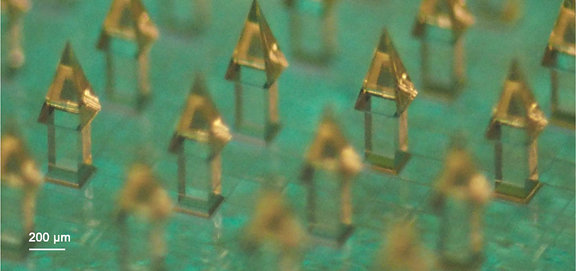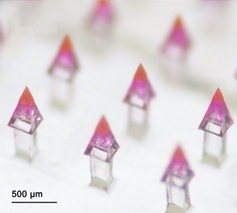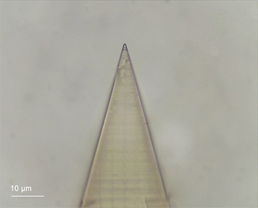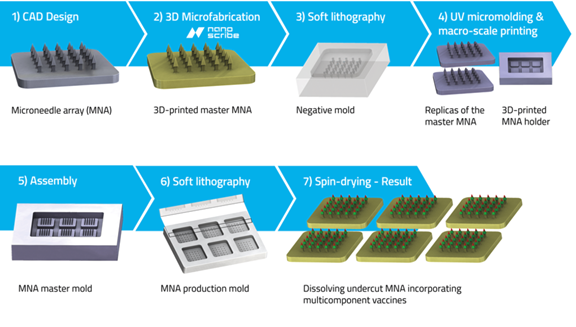
hotline:
17715390137
Tel/Wechat:
18101240246 (Technology)
0512-68565571
Email:mxenes@163.com (Sales Engineer)bkxc.bonnie@gmail.com
Scan the code to follow or search the official account on WeChat:
2D Materials Fronrier After paying attention,
click on the lower right corner to contact us,
Enter enterprise WeChat.
Professional Services Online

已传文件:photo/20208691941915.png
At present, the world is still struggling to fight various diseases including viral infections, cancers and drug allergies, and the delivery of vaccines through transdermal drug delivery systems has become the most important weapon for human self-protection. Scientists at the University of Pittsburgh used Nanoscribe‘s micro-nano 3D printer to make microneedle arrays (MNAs), and successfully developed a new type of skin microneedle array drug delivery system. They applied additive manufacturing technology to the production of microneedle array prototypes, and used it as the main model to replicate and expand the production of soluble microneedle arrays. Researchers said it is expected to enter clinical trials and put into use in the future.
3D-printedprototype of an array of microneedles. These needles are designed for the efficient delivery of vaccines into specific skin layers.
Image: EmrullahKorkmaz, University of Pittsburgh
In order to prevent multiple diseases safely and effectively, researchers around the world are actively developing different vaccines, including COVID-19, which is caused by the SARS-Cov-2 coronavirus, which is now raging around the world. Vaccines can help us fight infectious diseases by stimulating the human immune system. However, the traditional vaccination method by subcutaneous injection, that is, the delivery of the antigen to the muscle or subcutaneous tissue, rather than the skin microenvironment, will be accompanied by varying degrees of pain, and the traditional vaccination method is not highly immunogenic. It may cause adverse immune reactions in patients.
Image: Emrullah Korkmaz, University of Pittsburgh
Nanoscribe‘s printing equipment has a high degree of 3D design freedom and a humanized operating system. Therefore, researchers do not have to worry about the complexity of the design when designing new vaccine delivery technologies. At the same time, for medical scientists, it can be successful It is very exciting to apply medical concepts to reality. This also proves that 3D micro-nano processing technology has become a key technology for realizing skin drug or vaccine delivery systems.
To ensure that the new drug delivery system can successfully deliver the vaccine to the human body through the skin, each part of the microneedle array must be carefully designed. The tip radius of the microneedle is the key to be able to penetrate the skin tissue. The sharper the needle, the smaller the tip radius, the better the skin penetration. In addition, the rounded corners of the base also play a key role in improving the strength of the microneedle in practical applications. Nanoscribe‘s two-photon micro-nano 3D printing equipment can perfectly produce micro-needles with nanometer-level resolution, and can optimize the design according to different parameters without any complicated requirements.
Image: Emrullah Korkmaz, University of Pittsburgh
Copy the entire column of mass production microneedles
The soluble microneedle array is made of water-soluble biological materials. In a dry state, the microneedles can be aligned mechanically to penetrate the surface layer of the skin, namely the stratum corneum. After being inserted into the skin, the microneedles absorb the skin moisture and quickly dissolve and deliver the same amount of biological cargo to the skin microenvironment.
The use of 3D micro-nano processing to manufacture microneedle array prototypes is a key technology for mass production of soluble microneedle arrays. From the initial CAD design, a 3D printed microneedle array (MNA) can be made in one step. Then use soft lithography, such as nanoimprint technology, to make the 3D printed elastomer negative master of MNA. The master is cured by UV light to make a copy. Finally, multiple sets of copies (for example, 6 in the case) are installed on the 3D printing bracket manufactured by PolyJet3D printing technology. As shown in the figure, the researchers made a microneedle array model through this series of methods, and finally made an MNA with a multi-component vaccine using rotary thermal drying technology.
Andrea Gambot, MD, associate professor of the School of Dermatology, said: “You never know when the next epidemic will come, which is why it is important to fund vaccine research.” This new vaccine delivery system is one This is a more effective and high-tech version that can be transferred between patients.
Nanoscribe3D micro-processing technology used in new skin vaccine delivery system
In order to overcome this problem, scientists and engineers from the University of Pittsburgh Department of Dermatology, Department of Bioengineering, Institute of Clinical and Translational Sciences, McGowan Institute of Regenerative Medicine, and UPMC Hillman Cancer Center formed an interdisciplinary scientific research team to jointly develop New soluble microneedle skin vaccine delivery system. Researchers from the University of Pittsburgh’s Nanofabrication and Characterization Fund (NFCF) used Nanoscribe’s Photonic Professional GT series of two-photon micro-nano 3D printing equipment to make prototype microneedle arrays to produce soluble microneedle arrays. Studies have found that the skin contains dense antigen-presenting and immune helper cells, which is more suitable for vaccination, and this new drug delivery technology can promote the body‘s strong and lasting immunity through the skin.

Dissolving undercut microneedles integrating fluorescently-labeled vaccine components.

3D-printed microneedle with a sharp tip.

This information is sourced from the Internet for academic exchange only. If there is any infringement, please contact us to delete it immediately.

| Reminder: Beijing Beike New Material Technology Co., Ltd. supplies products only for scientific research, not for humans |
| All rights reserved © 2019 beijing beike new material Technology Co., Ltd 京ICP备16054715-2号 |